The NIH Chemical Waste Services (CWS) has an effective recycling program in place for most types of collected waste for beneficial reuse. The waste resource materials are securely packaged and shipped to NIH-approved recycling facilities at a reasonable cost and rebate. Through the chemical waste recycling program, the NIH has been successful in reducing the quantity of chemical waste that would otherwise be disposed in a manner with greater environmental impact. Recycled chemical waste is returned to the economic mainstream in the form of raw material for new products. The types of recycled waste include:
Batteries
All types of batteries are collected by CWS for recycling. These include alkaline, lithium, rechargable, coin batteries, lead-acid and all other types. Uninterruptible Power Source (UPS) batteries must be removed from the UPS casing prior to pick-up. For battery removal service, call the Division of Scientific Equipment and Instrumentation Services (DSEIS) at 301-496-4131.
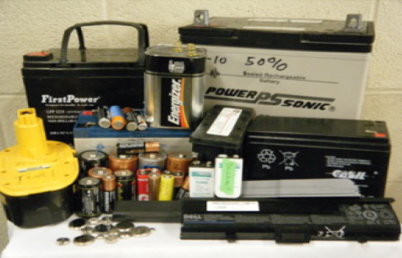
Lead-Acid & Gel Batteries - these batteries are collected and placed on wooden pallets for accumulation during storage. Their terminals are concealed with electrical or duct tape to avoid electrical discharge on contact with other terminals, which can result in sparks that could start a fire. The full pallets are shrink-wrapped and secured with bands to keep them intact during transportation to a permitted recycling facility.
Beneficial Reuse: lead-acid batteries are broken apart in the recycling process and the lead, plastic and acid are separated. The lead is melted, poured into ingots and delivered to battery plants to be reused in new batteries, bullets and lead bricks for radioactive material shielding. The plastic is melted and made into new battery cases, toys and other parts, while the acid is reused or neutralized and discharged.
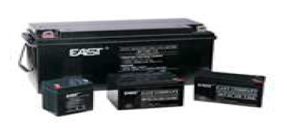
Alkaline Batteries - these batteries are collected in translucent plastic containers that are available from the CWS. The full containers are collected by the CWS upon request. The batteries are consolidated into larger drums that are shipped for recycling.
Beneficial Reuse: alkaline batteries are fully recycled and used to produce various types of products. These include new alkaline batteries, carbon wire, jewelry, shotgun casings, plastic bottles and numerous other consumer items.
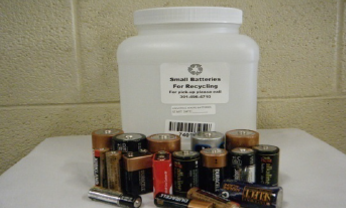
Rechargeable Batteries - these batteries consist of nickel-cadmium (Ni-Cads), nickel metal hydride, lithium or various other components. They are individually bagged and placed in a DOT shipping container for recycling processing at an approved facility.
Beneficial Reuse: nickel-cadmium batteries are processed in a metal recovery furnace. The reclaimed cadmium is used in the production of new nickel-cadmium batteries for cell phones, drills, computers, cameras, toys and games. The cadmium is also used as a corrosion resistant coating. The reclaimed nickel is used in the manufacturing of stainless steel products like sink parts, faucets, furniture, switch plates and wires.
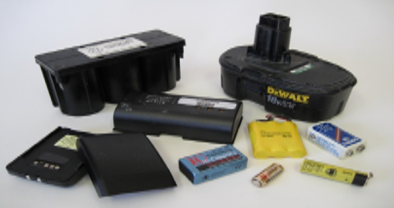
Empty Chemical Bottles
Empty chemical bottle recycling includes all glass, plastic and metal bottles and containers that previously contained hazardous or non-hazardous chemicals (solid or liquid) and should be collected by CWS. Bottles include empty containers of buffer, culture media, saline and other miscellaneous products. The bottles should be empty without chemical residue and with the cap or lid on. Collect residue in a chemical waste container and do not rinse the empty bottle. Contact CWS at 301-496-4710 or email
depchemwaste@od.nih.gov for the delivery or pickup of the plastic totes used to accumulate empty bottles. All empty bottles and totes are to be stored inside the lab, not in the aisle or hallway. Do not transfer empty chemical bottles or chemical wastes across corridors from one lab to another for storage or consolidation with other waste.
Empty containers that previously contained infectious or radioactive material will not be accepted and should be disposed according to the
NIH Waste Disposal Guide.
Do not place empty chemical bottles in commingled recycling bins, trash cans or in "Disposable Labware and Broken Glass" bins. Do not place any empty soda cans, juice bottles or water bottles in these totes.
Collected empty chemical bottles are sorted at the Building 21 hazardous waste facility and are later picked up by the sub-contractor and transported for recycling into bottles, marble and fiberglass.
There are 4 types of totes available for collecting empty chemical bottles with different sizes to occupy the limited storage space in labs. The shape, dimension and capacity of these totes are:
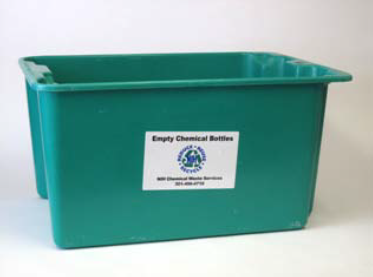
|
The large rectangular tote is 25”L x 20”W x 14”H, weighs 12.3 pounds and has a 30 gallon capacity. It is made of high strength, fiberglass reinforced polyester resin that won’t bend, warp or deform under extreme conditions.
|
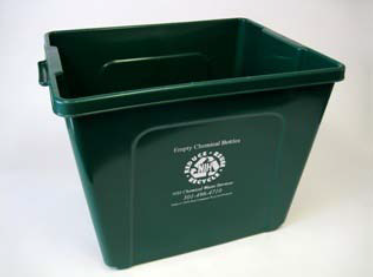
|
The medium rectangular tote is 19”L x 16”W x 15.5”H, weighs 3.95 pounds and has a 20 gallon capacity. It is made of high-density polyethylene (HDPE) with 100% post-consumer recycled content.
|
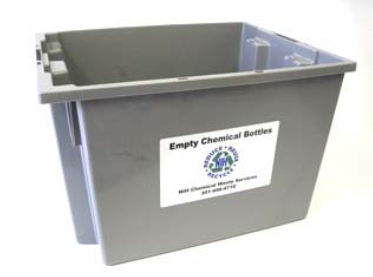
|
The small rectangular tote is 19.5”L x 15.5”W x 13”H, weighs 4.2 pounds and has a 17 gallon capacity. It is molded from high-density polyethylene (HDPE) to resist rust, corrosion or warping.
|
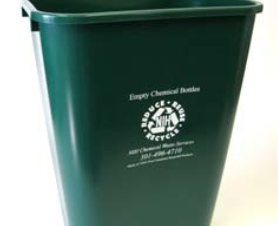
|
The small upright tote is 15.25”L x 11”W x 19.9”H, weighs 2.93 pounds, has a 14 gallon capacity and is best for labs with limited floor space. This container fits underneath counter tops. It is made of high-density polyethylene (HDPE) with 100% post-consumer recycled content.
|
Solvents with High BTU Value
The NIH uses large quantities of organic solvents in research and support operations. Solvents like acetonitrile, ethyl acetate, hexanes, xylene, acetone and alcohols are used in research processes to synthesize, extract, isolate or purify chemicals of biomedical interest. These spent liquids are collected in the labs in blue plastic carboys, white solvent safety cans or bottles of various sizes (as illustrated below). The collection of solvent effluent from an HPLC unit is also shown below draining into a 5-gallon blue carboy.

The waste-containing carboys are taken to the Building 21 Processing Facility where they are bar-coded into the NIH Waste Management Tracking Information System (WMTIS) for inventory before storage at designated locations. The carboys are sampled individually and tested on-site for flammability, mercury and radioactivity before being transferred into 55-gallon metal drums that are labeled for shipment. The spent solvent drums are transported weekly to approved companies for use as a fuel substitute in their manufacture of cement, rather than destruction at hazardous waste incinerators.
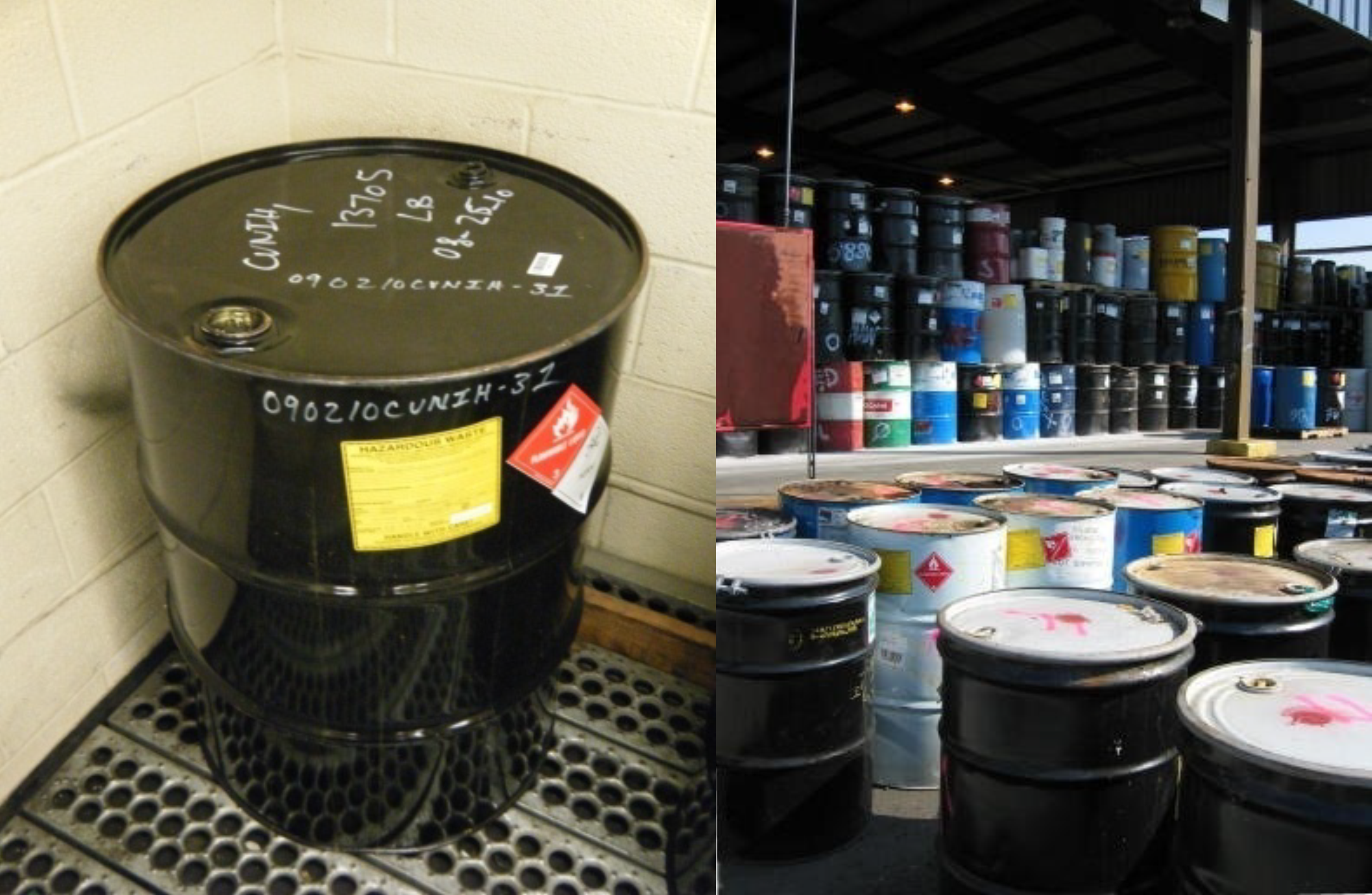
Fluorescent & HID Lamps, Mercury (Elemental & Debris)
Fluorescent light-tubes, compact fluorescent bulbs, mercury and sodium vapor lamps, ultraviolet and high-intensity discharge (HID) lamps and all other mercury containing devices (thermometers/thermostats) are collected by CWS for processing and shipment.

The 4 foot straight fluorescent lamps should be placed in a 4 foot fiber container and the u-shaped and 2 foot lamps should be placed in a 30 gallon fiber container. These shipping containers are securely closed and properly labeled for shipment to a recycling plant for mercury, glass and aluminum recovery. The beneficial re-use of these three recovered by-products are:
Mercury products in our homes, offices or schools are considered safe as long as they are in good working condition. When these items are not handled properly or are carelessly disposed of, they can become a health hazard, especially if they break and mercury is released to the environment. Common mercury-containing items are compact fluorescent lamps, thermometers, switches, flame sensors, and dental amalgam. Fluorescent lamps are still the main source for mercury reuse.
Glass can be recycled infinitely without losing its purity or strength. While the primary end product of recycled glass is new glass bottles and jars, there are some other uses for recycled glass in the manufacturing industry like in the production of fiberglass, marbles, eco-glass, beads, synthetic marble, roof tile, industrial flooring, jewelry, marblite and glassphalt.
Aluminum end caps from light tubes are recycled. Aluminum is a silver-white metal and is very light in weight, but still strong. Aluminum is ductile, so it can be drawn into wires or pressed into sheets and foil. Its light weight and resistance to corrosion make it ideal for use in aircraft, automobiles, beverage containers and buildings. It is also used in the manufacturing of radiators, cables, wires, windows, doors, pans and cooking pots.
Silver Recovery Units and Cassettes
Cassettes and Silver Recovery Units/Cartridges are collected by CWS for recycling. X-ray film should also be collected for proper disposal. These items are picked up and taken to the Building 21 Processing Facility and placed into larger accumulation drums until they are full for shipment. Most ICs have service and maintenance contracts for their photographic processing machines, which include pick up and replacement of cartridges for silver recycling.
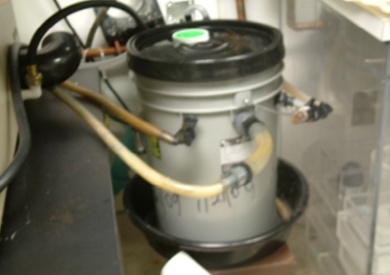
| 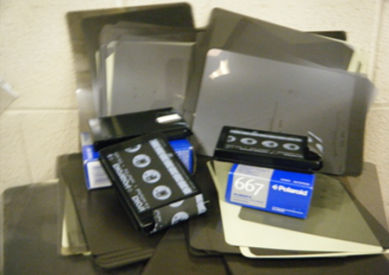
|
The NIH Surplus Chemical Redistribution Program
The NIH Surplus Chemical Redistribution Program was implemented in April 2013 at the NIH Hazardous Waste Facility using the NIH Free Stuff program for posting and sharing of unused chemicals collected as waste. This is a sustainable, innovative program for the 4000 NIH research laboratories that generate large quantities of chemical waste that is collected by CWS. The chemical waste collected by this program is discarded unused chemicals, referred to as surplus chemicals. These chemicals are sorted and placed into a surplus chemical repository for redistribution upon online requests by intramural researchers. The collected items are sealed or unopened and unexpired chemicals from NIH labs that are moving with limited storage space or that have discontinued a research process and no longer need the item.
In the past, DEP had little success implementing that sharing of unused chemicals during lab moves within institutes and buildings. The design of the NIH Free Stuff website by NIAID solved this issue and provided DEP with stewardship and complete control of redistributing discarded unused chemicals. This is achieved by maintaining an online inventory of surplus usable chemicals that are stored at the NIH Hazardous Waste Facility with immediate distribution to research labs for free. Consequently, the program became a smart economic and environmental accomplishment that supplements budget cuts to NIH Institutes and Centers (ICs). The program is a free service on a first come, first serve basis offered to all NIH intramural researchers through the DEP CWS program. The program is being expanded to include NIH leased facilities in Maryland and has been in existence at the NCI Frederick facility since 2004.
The NIH Free Stuff website is easy to use by the NIH intramural community to post, search and exchange items for free in several categories like supplies, equipment and chemicals. An email correspondence is generated between NIH employees posting items and requesters to arrange for the transfer of the items. However, the chemicals and reagents category is under DEP custody since it involves the transfer of chemicals between buildings. Researchers on the Bethesda campus are encouraged to post and exchange chemicals within the same building. This program is part of the Toxic Chemical Reduction Initiative that aims to replace and minimize the use and disposal of toxic chemicals, which is beneficial to the NIH, the environment and the DEP budget. Participation in the program is simply a mouse click away on the NIH Free Stuff website to select and make a request for free chemicals and reagents that are delivered to your lab within one or two days free of charge.
Relocating labs that have surplus unopened and unexpired chemicals to donate to the program or chemical waste to dispose should call CWS at 301-496-4710 or email DEPChemWaste@od.nih.gov two months prior to the move date to arrange for pickup and redistribution. Please place a chemical waste tag on the surplus chemicals to specify they are to be redistributed. Please do not request for chemicals you will not use in a reasonable time period.
The NIH Surplus Chemical Redistribution Program is a "dream come true" recycling achievement for DEP and the NIH community. The program generates a substantial monthly procurement savings for the NIH based on diversion of discarded chemicals that are used in research, as shown below.
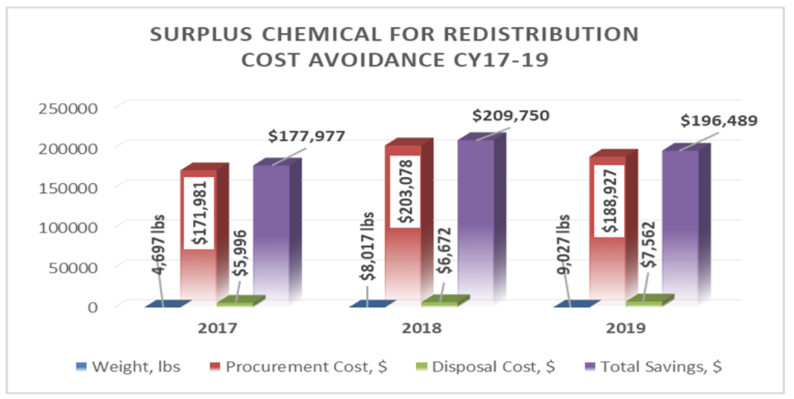
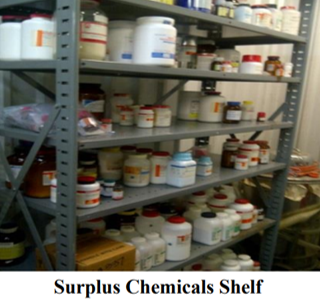
| 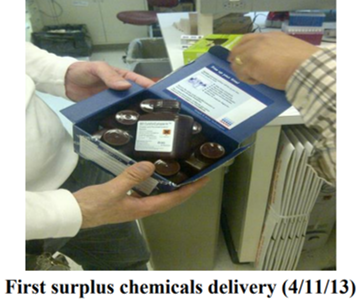
|
NIH Solvent Recovery Program
The NIH Solvent Recovery program started in January 2013 as a pilot study with DEP staff working with two volunteer histology laboratories to determine the feasibility of implementing solvent recovery on the NIH Bethesda campus. A solvent recovery system was used to recycle waste xylene, alcohol and formalin collected from NIH laboratories. The pilot study yielded pure distilled solvents with successful results. The recovered products were returned to the researchers to be reused in their laboratory processes. The researchers reported positive results with no distinction between the uses of recycled product versus unused commercial product. This was a major accomplishment. Based on these positive results, DEP purchased a commercial system, which was installed at the NIH Hazardous Waste Facility during July 2013 and it is now operational. Operation of the recycler to recover spent solvents for reuse has already resulted in considerable cost savings for the NIH with five laboratories currently participating in the program. More substantial savings will be realized as the program is expanded to include additional laboratories. NIH Bethesda campus researchers that are interested in participating in this program should call DEP at 301-496-7990.
The implementation of the NIH Solvent Recovery program is one of the best sustainable recycling programs ever for the NIH. This new program has had a significant impact NIH-wide providing a cost savings to NIH researchers that utilize this program. The program also promotes sustainable business practices designed to improve NIH environmental performance and conservation of resources. Additionally, this program helps the NIH achieve its HHS Strategic Sustainability Plan (SSP) goals and NIH Green Initiatives for pollution prevention, resource conservation and toxicity reduction. The program supports NIH waste minimization goals mandated by environmental regulations and Executive Orders.
Thus far, five ICs are participating in this program and it will be expanded to all ICs and other NIH facilities in the near future in order to save NIH money that can be better utilized towards biomedical research.
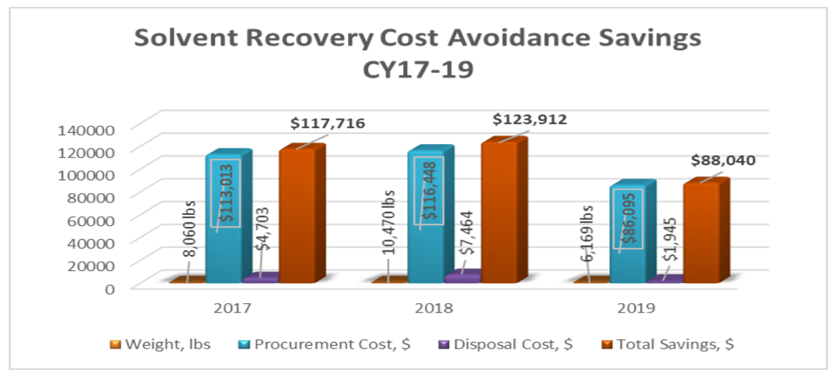
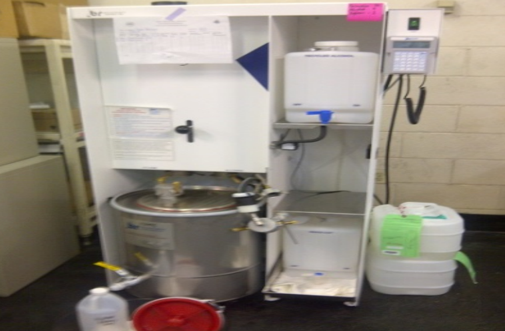
Outreach Information
NIH Chemical Waste Recycling Program Brochure
Empty Chemical Bottle Recycling Article
Empty Chemical Bottle Recycling Flyer
NIH Chemical Waste Recycling Program Poster